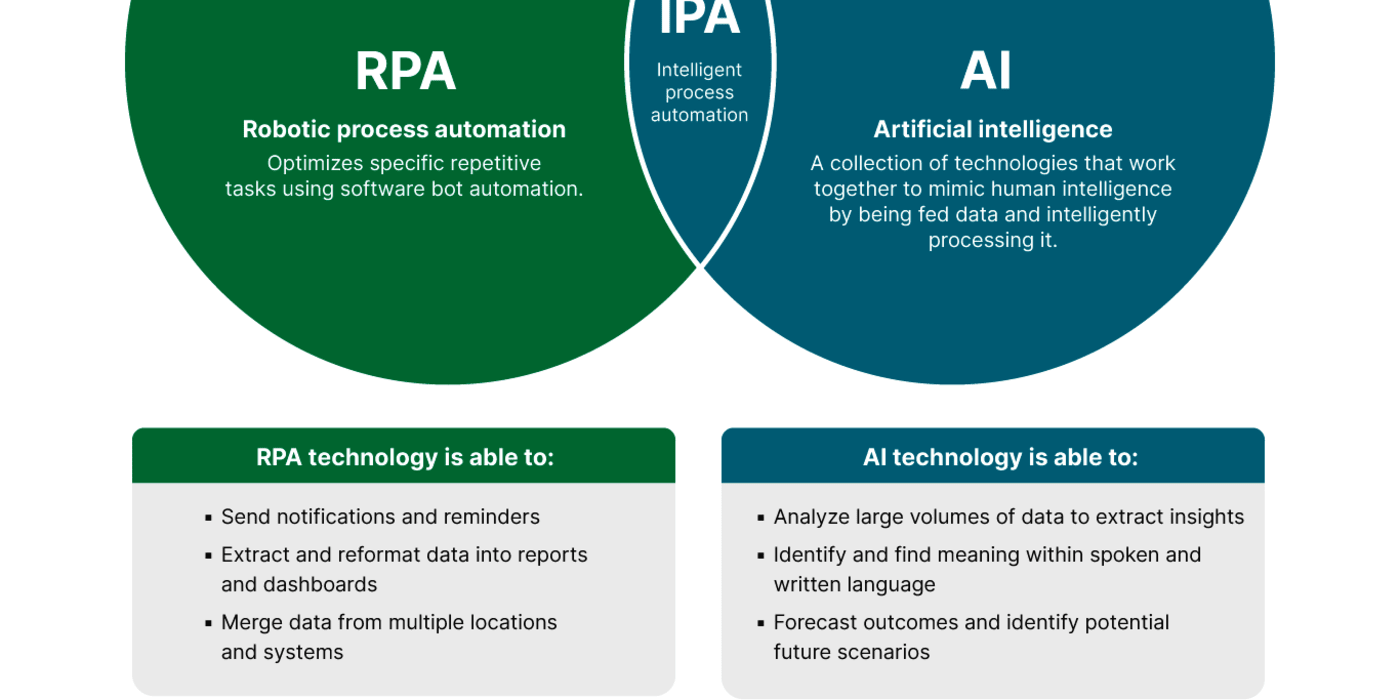How RPA and AI drive end-to-end intelligent process automation
The combination of RPA and AI in intelligent process automation transforms the way organizations operate by enhancing efficiency, improving decision-making and streamlining processes.
The combination of RPA and AI in intelligent process automation transforms the way organizations operate by enhancing efficiency, improving decision-making and streamlining processes.

Intelligent process automation (IPA) has become a cornerstone of efficiency and innovation. Robotic process automation (RPA) and artificial intelligence (AI) stand at the forefront of this transition, providing organizations a combination capable of revolutionizing the way operations are carried out.
We delve into the difference between RPA and AI, its common uses, how they interact and the best way to prepare your organization to leverage both technologies in an IPA strategy.
> Learn more | A deep dive into RPA and intelligent automation
The difference between RPA and AI is that RPA automates repetitive tasks based on fixed rules and inputs, while AI involves self-learning systems that can analyze data, make decisions and adapt over time.
RPA is a technology that utilizes software robots (sometimes simply called bots) to carry out routine tasks. RPA operates within the confines of preprogrammed business rules, making it adept at managing structured tasks and adhering to a set of predefined prompts.
For instance, RPA could be employed to automate routine tasks such as data entry or invoice processing, performing the tasks much quicker and without error.
AI, on the other hand, is a broader concept referring to machines or software that exhibit capabilities that mimic or simulate human intelligence. For example, customer service chatbots can leverage natural language processing (NLP) to understand context and respond to customer inquiries with a high degree of relevance and personalization.
Think of AI as the brain, and RPA as the hands.
While RPA automates repetitive tasks without the need for human intervention, AI simulates human intelligence and decision-making.
Although distinct in their capabilities, RPA and AI often work in tandem to complement each other's strengths.
Here’s how they work side by side if a customer at a bank wants to open an account:
RPA processes:
AI processes:

According to Grand View Research, the global intelligent document processing market is projected to reach a staggering $11.29 billion by 2030, underscoring the rapid adoption of intelligent processing automation (IPA) technologies across industries.
IPA combines technologies such as RPA, AI, machine learning (ML) and optical character recognition (OCR). Unlike traditional automation, IPA can learn from its interactions and improve over time.
It’s a combination that offers an integrated approach to automation, capable of executing tasks, learning from data patterns and driving informed decisions — streamlining end-to-end business and IT processes across functions.
> Learn more | How to drive more value from automation with intelligent capture
Here are more benefits to leveraging RPA and AI for end-to-end IPA:
RPA drives efficiency throughout repeatable tasks but may struggle when it comes to managing unstructured data. AI uses human-like reasoning to complete more complex tasks by being more aware of context and various exceptions.
In document processing, AI technology may employ techniques such as text recognition, entity extraction and other NLP capabilities to make sense of the content. This ensures the system becomes context-aware, understanding not just the information but also the nuances and relationships within the data.
The combination of RPA and AI enables a more comprehensive and holistic view of customer data. RPA can integrate data from various sources, ensuring a unified customer profile. After that, AI algorithms can analyze this data to identify patterns and provide more valuable insights.
For example, an AI system might recognize that certain customer segments prefer online shopping during specific times or respond positively to particular promotions. These insights go beyond what traditional analytics might offer, as AI can discern complex relationships within the data.
Findings from a Deloitte report suggest that organizations currently scaling intelligent automation say they have already achieved a 27% reduction in costs on average from their implementations to date.
In the healthcare sector, RPA can automate the claims processing system, ensuring that billing and payments are error-free and timely while AI can be used to detect fraudulent claims. The outcome is a reduction in costs, as both administrative efficiency and fraud prevention are maximized.
RPA and AI together bolster compliance efforts by ensuring strict adherence to protocols and thus, reducing risks.
In financial institutions, RPA is used to automate anti-money laundering checks while AI continuously monitors transactional data for suspicious activity. This collaboration ensures strict adherence to regulations and safeguards both the reputation and financial stability of the institution.

Hear from industry experts from Hyland and Deep Analysis as they cover key findings from the recent Deep Analysis: Market Momentum Index report. Learn the current trends, actionable strategies and best practices to overcome challenges like data quality and process optimization.
Here are nine common use cases where RPA and AI work in unison to reshape how organizations operate, as well as the end benefits your customers can see.
RPA bots can easily scale to handle an increased volume of customer service tasks without the need for additional hiring. This comes in handy when dealing with sudden spikes in customer inquiries, ensuring that the service remains efficient and responsive. These include:
AI comes in to “triage” ticket creation and routing. AI algorithms can analyze the content of customer queries, categorize them and prioritize based on urgency or complexity.
RPA can automate repetitive accounting processes like processing invoices, while AI can spot cost-saving opportunities and significant financial risks. By maximizing both financial efficiency and accuracy, this combination lowers the likelihood of human error and promotes accurate financial reporting.
RPA and AI can also synergize to transform mortgage applications processing and know your customer (KYC) procedures. RPA starts with automating repetitive tasks such as data entry and document verification, while AI — leveraging NLP and ML — enhances KYC procedures by automating identity verification and risk assessment, learning from historical data to detect potential risks or fraud.
> Read more | Modernization, automation and AI in financial services
RPA and AI are essential to risk management and compliance because they guarantee risk assessments, compliance checks and other crucial protocols are never mishandled.
In the healthcare industry, RPA can automate the processing of insurance claims while AI detects irregularities or fraudulent claims. As a result of this cooperation, the chances of fraud and regulatory fines are lowered due to the detailed risk assessments and compliance checks being made.
RPA bots can automatically reconcile received goods with purchase orders, update inventory databases and generate reports.
Predictive analytics, a subset of AI, could then use historical data to forecast demand more accurately. Machine learning algorithms can analyze patterns in purchasing behavior, season preferences and other external factors to predict future inventory needs, so your business can reduce excess inventory costs and optimize stock levels.
While AI can help match job candidates to relevant roles, RPA can handle repetitive HR-related onboarding duties like entering new employee data into systems.
RPA and AI integration also allows for the creation of dynamic onboarding workflows. AI can then assess the individual needs and preferences of new employees, while RPA automates the execution of personalized onboarding plans, adapting the process based on real-time feedback and evolving employee requirements.
While AI can help match job candidates to relevant roles, RPA can handle repetitive HR-related onboarding duties like entering new employee data into systems.
RPA and AI integration also allows for the creation of dynamic onboarding workflows. AI can then assess the individual needs and preferences of new employees, while RPA automates the execution of personalized onboarding plans, adapting the process based on real-time feedback and evolving employee requirements.
NLP can be employed to analyze textual data, such as customer reviews or social media comments, providing a more nuanced understanding of sentiment and preferences. RPA can then integrate with customer relationship management (CRM) systems and email marketing platforms to help trigger personalized email campaigns.
The synergy between AI and RPA is in their complementary roles. While AI analyzes and interprets intricate consumer data to inform targeted marketing strategies, RPA automates the execution of these strategies, ensuring personalized content is delivered efficiently and in real-time.
Setting up and managing appointments in healthcare takes a lot of time. But with AI and RPA application, patients can easily book appointments and get personalized messages to confirm, change or update their records.
At the same time, RPA automates the retrieval and storage of patient data, whereas AI helps improves healthcare diagnostics by being able to spot irregularities in medical imaging like X-rays or MRI scans. This combination helps eliminate diagnostic errors, expedite patient care and ultimately improve healthcare outcomes.
AI actively observes and analyzes customer interactions with products, utilizing machine learning algorithms to understand consumer behavior and preferences.
RPA can automatically send tailored product recommendations via email or within an online platform. Both AI and RPA in the retail space result in a win-win situation: Customers benefit from a more tailored and satisfying shopping experience, and organizations can use the data to drive more purchases as a result of strategically targeted recommendations.
In industries with heavy machinery or infrastructure, AI can predict when equipment might fail; RPA can automatically schedule maintenance or order replacement parts.
AI analyzes numerous data inputs, such as usage patterns, to forecast maintenance needs while RPA complements this by automating the process of scheduling maintenance and ordering replacement parts. This collaboration minimizes downtime, reduces maintenance costs and ensures the continuous operation of critical machinery.
> Read the case study | How this fashion company saves more than 8 hours per day in manual labor with RPA
Here's a step-by-step guide to ensure a smooth integration:
Organizations championing end-to-end intelligent automation can meet — and exceed — evolving customer expectations. When most of the manual “legwork” is automated across functions and teams, your human workforce gets to focus on the bigger picture.
Discover how Hyland’s intelligent automation technology fuels your plans for digital transformation, so more meaningful work gets done at both customer and employee levels.
Learn more: Hyland Experience Automate
Browse more related articles:

AI transforms records management by automating classification, enhancing governance and unlocking insights from unstructured content to ensure compliance.

Here's how intelligent automation minimizes the manual "legwork" and ramps up your team's ability to focus on high-level strategy.

Intelligent automation is a game-changer, but first you need to understand what it is and how it can contribute to achieving your business objectives.